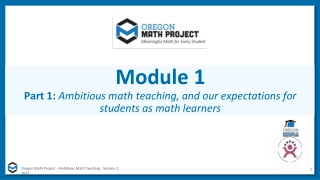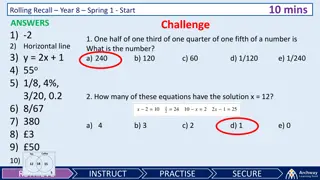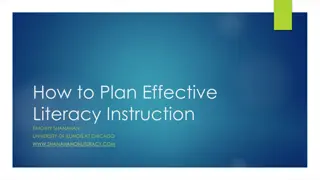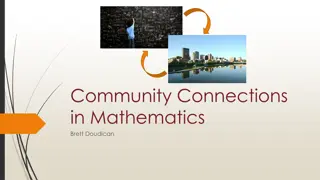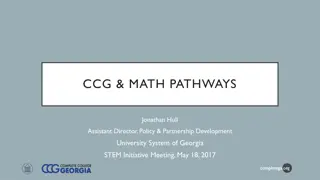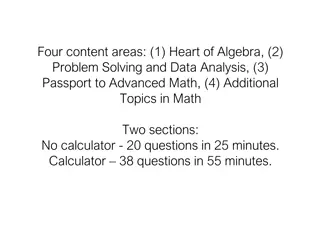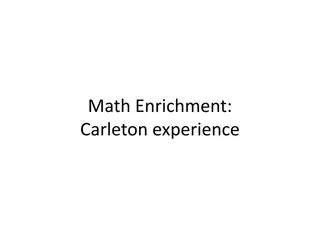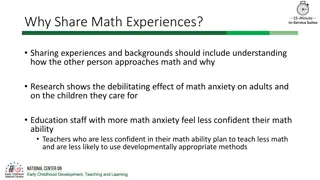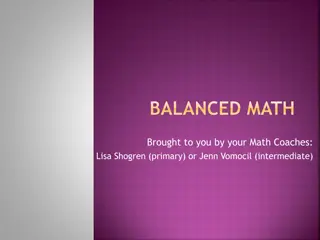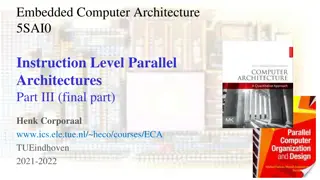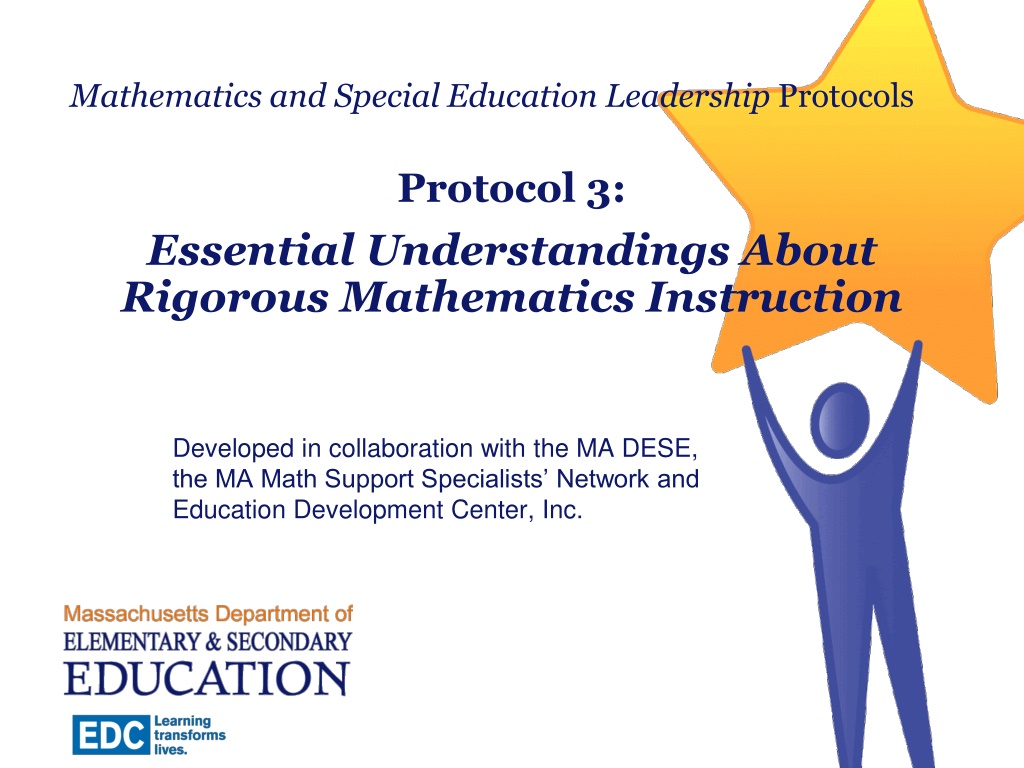
Understanding Rigorous Mathematics Instruction in Special Education Leadership Protocols
Explore essential understandings about rigorous mathematics instruction in special education, including shared beliefs, aligning barriers, and strategies for responding to diverse learning needs. Gain insights on increasing mathematical rigor and defining rigorous mathematics experiences for all students.
Download Presentation

Please find below an Image/Link to download the presentation.
The content on the website is provided AS IS for your information and personal use only. It may not be sold, licensed, or shared on other websites without obtaining consent from the author. Download presentation by click this link. If you encounter any issues during the download, it is possible that the publisher has removed the file from their server.
E N D
Presentation Transcript
Mathematics and Special Education Leadership Protocols Protocol 3: Essential Understandings About Rigorous Mathematics Instruction Developed in collaboration with the MA DESE, the MA Math Support Specialists Network and Education Development Center, Inc.
Clarifying the Work of the Team 1: Shared Beliefs About Mathematics Instruction for Students with Disabilities 2: Essential Understandings About Students with Disabilities 3: Essential Understandings About Rigorous Mathematics Instruction 4: Aligning Barriers and Strategies 5: Responding to a Range of Learning Needs 2 Massachusetts Department of Elementary and Secondary Education
Protocol 3 Goals To establish a shared definition of a rigorous mathematics experience for all students; To become familiar with how the Standards for Mathematical Practice help deepen students understanding of content. 3 Massachusetts Department of Elementary and Secondary Education
Agenda Brainstorming a Definition of Rigorous Mathematics Experience for All Students Examples of Increasing Mathematical Rigor Introduction to Standards for Mathematical Content integrated with the Standards for Math Practices (SMPs) Use Video to Better Understand Content Standard 7.EE.4 and Math Practice #3 Establishing a Shared Definition of Rigorous Mathematics 4 Wrap up, next steps Massachusetts Department of Elementary and Secondary Education
Examples of Increasing Mathematical Rigor What characterizes those problems that are more rigorous? How does that fit with your initial brainstormed definition of rigor? 5 Massachusetts Department of Elementary and Secondary Education
Increasing the Mathematical Rigor 6 + 5 = _______ What pairs of numbers add up to 11? What pairs can you find if you don t restrict yourself to whole numbers? How do you know you have them all? 6 Massachusetts Department of Elementary and Secondary Education
Increasing the Mathematical Rigor Increasing the rigor does not necessarily mean going faster or going further ahead in the curriculum It means going deeper What do we mean by going deeper? 7 Massachusetts Department of Elementary and Secondary Education
Increasing the Mathematical Rigor What is the rule for finding the mean (or average) of a set of numbers? 8 Massachusetts Department of Elementary and Secondary Education
Increasing the Mathematical Rigor Find the mean (average) of the following set of eight numbers: 4, 6, 9, 5, 13, 12, 9, 10 9 Massachusetts Department of Elementary and Secondary Education
Increasing the Mathematical Rigor Find two different sets of eight numbers, each with a mean (average) of 8.5 (The numbers don t have to be integers.) 10 Massachusetts Department of Elementary and Secondary Education
Increasing the Mathematical Rigor The mean age of males in MA is 40.6 and the mean age of females in MA is 36.2. Maria says that she has a shortcut for finding the mean age of all the people in MA: You just take the mean of 40.6 and 36.2. It s 38.4 Is she correct? Why or why not? 11 Massachusetts Department of Elementary and Secondary Education
Increasing the Mathematical Rigor What is the area formula for a rectangle? 12 Massachusetts Department of Elementary and Secondary Education
Increasing the Mathematical Rigor Find the area for a rectangle with a length of 7 and a width of 3. 13 Massachusetts Department of Elementary and Secondary Education
Increasing the Mathematical Rigor What s the largest possible area of a rectangle that has a perimeter of 16 inches? What s the smallest possible area? 14 Massachusetts Department of Elementary and Secondary Education
Increasing the Mathematical Rigor Given a rectangle with a fixed perimeter (i.e. the total perimeter is a particular length and that total length does not change), describe how the area changes as the length and width of the rectangle change. 15 Massachusetts Department of Elementary and Secondary Education
Increasing the Mathematical Rigor Rigor doing more and doing it faster; heavier work load; Rigor = going into greater depth; attending to learning and understanding concepts, not just completing procedures. 16 Massachusetts Department of Elementary and Secondary Education
2011 MA Math Frameworks - 2 Key Parts 1) Standards for Mathematical Content K-8 standards presented by grade level Organized into domains that progress over several grades Grade intros give 2 4 focal points at each grade level High school standards presented by conceptual category (Algebra and Functions, Geometric Measurement, etc.) 2) Standards for Mathematical Practice Carry across all grade levels Describe habits of mind of a mathematically proficient student 17 Massachusetts Department of Elementary and Secondary Education
Standards for Mathematical Practice 1. Make sense of problems and persevere in solving them. 2. Reason abstractly and quantitatively. 3. Construct viable arguments and critique the reasoning of others. 4. Model with mathematics. 5. Use appropriate tools strategically. 6. Attend to precision. 7. Look for and make use of structure. 18 8. Look for and express regularity in repeated reasoning. Massachusetts Department of Elementary and Secondary Education
The Math Content and Practice Standards These Standards are not intended to be new names for old ways of doing business. They are a call to take the next step. It is time for states to work together to build on lessons learned from two decades of standards based reforms. -2011 Massachusetts Curriculum Framework for Mathematics (page 14) 19 Massachusetts Department of Elementary and Secondary Education
These Math Practices Define the Next Step! They articulate how students must engage with the mathematics content in order to reason like a mathematician , not just compute like a calculator. 20 Massachusetts Department of Elementary and Secondary Education
Standards for Mathematical Practice The Standards for Mathematical Practice describe ways in which developing student practitioners of the discipline of mathematics increasingly ought to engage with the subject matter as they grow in mathematical maturity and expertise throughout the elementary, middle and high school years. 21 Page 18, 2011 Massachusetts Curriculum Framework for Mathematics Massachusetts Department of Elementary and Secondary Education
Getting Familiar with the Standards for Mathematical Practice Discuss: How do these math practices combined with math content fit or not fit with your own ideas of mathematical rigor? How do the math practices enhance the rigor of the content? 22 Massachusetts Department of Elementary and Secondary Education
Getting Familiar with the Standards for Mathematical Practice Few minutes to work on the Staircase Problem. Not necessary or expected to finish it just start it and share 1-2 ideas you have with someone else about how you re thinking about the problem. 23 Massachusetts Department of Elementary and Secondary Education
Content Standard 7.EE.4 Use variables to represent quantities in a real-world or mathematical problem, and construct simple equations and inequalities to solve problems by reasoning about the quantities. 24 Massachusetts Department of Elementary and Secondary Education
Getting Familiar with the Standards for Mathematical Practice As you watch the video, keep the following question in mind: What evidence of MP #3 do you see as the students work on the problem in the video? 25 Massachusetts Department of Elementary and Secondary Education
Getting Familiar with the Standards for Mathematical Practice Having watched the video and identified some possible examples of students use of MP #3, discuss: What evidence from the video did you see that you think embodies MP #3? 26 Massachusetts Department of Elementary and Secondary Education
Getting Familiar with the Standards for Mathematical Practice Based on what you re thinking at this point, what are three things that now seem central to you about rigorous mathematics? 27 Massachusetts Department of Elementary and Secondary Education
Wrap Up Summarize where you ended up today Parking lots questions Any follow-up steps? 28 Massachusetts Department of Elementary and Secondary Education
Next Time #1 Shared Beliefs About Math Instruction for Students with Disabilities #2 Essential Understandings About Students with Disabilities #3 Essential Understandings About Rigorous Mathematics Instruction #4 Aligning Barriers and Strategies #5 Responding to a Range of Learning Needs 29 Massachusetts Department of Elementary and Secondary Education


